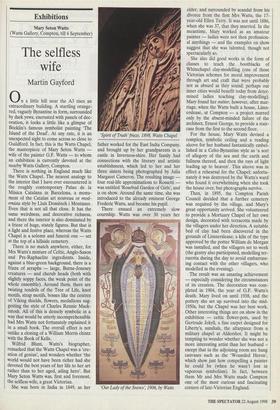Exhibitions
Mary Seton Watts (Watts Gallery, Compton, till 6 September)
The selfless wife
Martin Gayford
On a little hill near the A3 rises an extraordinary building. A startling orange- red, vaguely Byzantine in form, surrounded by dark yews, encrusted with panels of dec- oration, it looks a little like a glimpse of Bficldin's famous symbolist painting 'The Island of the Dead'. At any rate, it is an unexpected sight to come across so close to Guildford. In fact, this is the Watts Chapel, the masterpiece of Mary Seton Watts wife of the painter G.F. Watts — to whom an exhibition is currently devoted at the nearby Watts Gallery, Compton.
There is nothing in England much like the Watts Chapel. The nearest analogy to the interior that I have ever encountered is the roughly contemporary Palau de la Musica Catalana in Barcelona, a monu- ment of the Catalan art nouveau or mod- emista style by Lluis Domench i Montaner. Even that is not all that close. It has the same weirdness, and decorative richness, and there the interior is also dominated by a frieze of huge, stately figures. But that is a light and festive place, whereas the Watts Chapel is a solemn and funeral one — set at the top of a hillside cemetery.
There is no match anywhere, either, for Mrs Watts's mixture of Celtic, Anglo-Saxon and Pre-Raphaelite ingredients. Inside, against a blue-green background, there is a frieze of seraphs — large, Burne-Jonesey creatures — and cherub heads (both with slightly soppy faces, the weak point of the whole ensemble). Around them, there are twisting tendrils of the Tree of Life, knot motifs, strap motifs, bosses like the centres of Viking shields, flowers, medallions sug- gesting the style of Charles Rennie Mack- intosh. All of this is densely symbolic in a way that would be utterly incomprehensible had Mrs Watts not fortunately explained it in a small book. The overall effect is not unlike a cloning of a William Morris chintz with the Book of Kells.
Wilfrid Blunt, Watts's biographer, remarked that the Watts Chapel was a 'cre- ation of genius', and wonders whether 'the world would not have been richer had she devoted the best years of her life to her art rather than to her aged, ailing hero'. But Mary Seton Watts was, first and foremost, the selfless wife, a great Victorian.
She was born in India in 1849, as her `Spirit of Truth' frieze, 1898, Watts Chapel father worked for the East India Company, and brought up by her grandparents in a castle in Inverness-shire. Her family had connections with the literary and artistic establishment, which led to her and her three sisters being photographed by Julia Margaret Cameron. The resulting image four real-life approximations to Rossetti was entitled 'Rosebud Garden of Girls', and is on show. Around the same time, she was introduced to the already eminent George Frederic Watts, and became his pupil.
There ensued an extremely slow courtship. Watts was over 30 years her `Our Lady of the Snows, 1906, by Watts elder, and surrounded by scandal from his divorce from the first Mrs Watts, the 17- year-old Ellen Terry. It was not until 1886, when she was 37, that they married. In the meantime, Mary worked as an amateur painter — ladies were not then profession- al anythings — and the examples on show suggest that she was talented, though not spectacularly so.
She also did good works in the form of classes to teach the bootblacks of Whitechapel clay-modelling (one of those Victorian schemes for moral improvement through art and craft that were probably not as absurd as they sound; perhaps our inner cities would benefit today from deter- mined ladies teaching clay-modelling). Mary found her métier, however, after mar- riage, when the Watts built a house, Limn- erslease, at Compton — a project marred only by the absent-minded failure of the architect, Ernest George, to provide a stair- case from the first to the second floor.
For the house, Mary Watts devised a complex, symbolic ceiling and a reading alcove for her husband fantastically embel- lished in a Celto-Byzantine style as 'a sort of allegory of the sea and the earth and fullness thereof, and then the rays of light leading up to heaven'. This alcove was in effect a rehearsal for the Chapel; unfortu- nately it was destroyed by the Watts's ward who found it overwhelming when she took the house over, but photographs survive.
Then, in 1895, the Compton Parish Council decided that a further cemetery was required by the village, and Mary's great opportunity arrived. She volunteered to provide a Mortuary Chapel of her own design, decorated with terracotta made by the villagers under her direction. A suitable bed of clay had been discovered in the grounds of Limnerslease; a kiln of the type approved by the potter William de Morgan was installed, and the villagers set to work (the gentry also participated, modelling ter- racotta during the day to avoid embarrass- ing contact with the other villagers, who modelled in the evening).
The result was an amazing achievement — especially considering the circumstances of its creation. The decoration was com- pleted in 1904, the year of G.F. Watts's death. Mary lived on until 1938, and the pottery she set up survived into the mid- 1950s, but the Chapel was her best work. Other interesting things are on show in the exhibition — celtic flower-pots, used by Gertrude Jekyll, a fine carpet designed for Liberty's, sundials, the altarpiece from a military chapel at Aldershot. It might be tempting to wonder whether she was not a more interesting artist than her husband except that in the adjoining room are hung canvases such as the 'Wounded Heron', which show just how compelling a painter he could be (when he wasn't lost in vaporous symbolism). In fact, between them Mr and Mrs Watts made Compton one of the most curious and fascinating corners of late-Victorian England.
























































 Previous page
Previous page